Although you don’t need to count the calories of every component of your meals after adopting the LCHF lifestyle, you do need to keep your daily amounts from each food group in check.
The easiest way to ensure you don’t sabotage your LCHF goals is to use a free online food tracker, at least until you are familiar with meal quantities.
How many calories you can eat a day depends on your age, gender, metabolic rate, activity level, BMI, and whether you want to maintain your present weight or lose weight.
After entering your details, the tracker calculates the number of daily calories for the weight goal you have chosen. Couldn’t be easier.
Another consideration is if you have a specific health challenge like diabetes, high blood pressure, or high triglycerides you wish to improve. These conditions respond very well to a low carbohydrate intake.
Making your meals
Remember the ideas behind LCHF are:
- Remove processed carbohydrates and sugary drinks from your life.
- Enjoy real food, as close as possible to the way Mother Nature made it for us.
- Enjoy carbohydrates from leafy vegetables and salads every day (they also provide plenty of minerals, vitamins, antioxidants, and fibre).
- Enjoy low-to-moderate protein from meat, poultry, fish, seafood, eggs, nuts, and cheese.
- Enjoy plenty of healthy fat from butter, coconut oil, olive oil, coconut, olives, and avocados.
And not forgetting:
- Only eat if you are hungry.
- Stop eating when you’re comfortably satisfied.
Finding meal suggestions and recipes
As I mentioned in the post ‘Shopping for the LCHF lifestyle‘, The Charlie Foundation website has many recipes, photos, and video guides for making delicious low carb, healthy fat meals.
The meals are designed to be very low carbohydrate in order to provide the maximum LCHF benefits for people with specific health issues.
Low carbohydrate intake is also very effective for losing weight, especially from the abdominal area, as well as for controlling diabetes, and other diseases associated with metabolic syndrome.
Even if you don’t have a particular health issue, you can happily use the delicious recipes as a starting point, and adjust the amounts of carbohydrate, protein, and fat to suit your personal goals.
As you’ll see, there’s an amazing variety of food recipes in the categories listed in the left margin of their homepage.
Home-made real food
If you buy real, fresh food and cook it at home you’ll know exactly what you’re eating.
Here’s a real-food breakfast our LCHF daughter, Kate, made for her partner, Karl. Looks really delicious, doesn’t it.
Egg omelette made like a wrap, with wilted spinach, bacon, cheese, and avocado – and of course cooked in healthy butter:
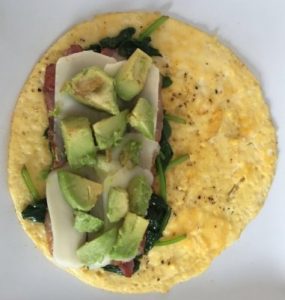
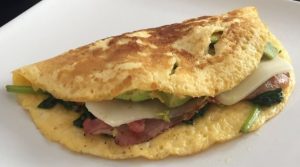
Kate doesn’t eat bacon, so her omelette had extra cheese instead of the bacon.
And here’s a lunch of leafy vegetables wok-fried in coconut oil, with a large free-range egg:
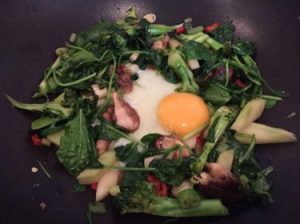
Not only looks good, it’s a really nutritious LCHF meal.
Cup and spoon instead of tracker
If you’re not the sort of person who uses technical things, instead of the online tracker you can easily measure your portions using two handy kitchen tools – spoon and cup.
Check out this day of meals from Dr Caryn Zinn’s excellent talk on starting the LCHF lifestyle:
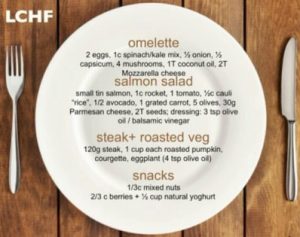
As you can see, the day’s meals are nice and varied and they’re easy to make using cup and spoon for measuring quantities.
And they’re all real food. That’s the key: real food our bodies are designed to eat.
Even if all you do is remove the factory-made food and drinks from your life, you’ll lose weight and vastly improve your long-term health.
Hand-eye method
Another possibility instead of measuring anything, is to mentally divide your plate into quarters.
On one quarter put a piece of protein about the size of the palm of your hand. Cover the rest of your plate with an assortment of leafy vegetables or salad leaves.
Drizzle a tablespoon of olive oil over the leaves, melt one or two teaspoons of butter on your protein choice, and season with pepper and salt to taste. The healthy fat makes the food taste so much better, and keeps hunger away, too.
Substitutes
If you find it hard not to have bread, rice, pasta, or potato, try these delicious substitutes.
Bread: There are many recipes online for grain-free bread. For example, this one looks really tasty.
Rice: Cut some cauliflower into small chunks and put them in the blender for a very short time, until the cauliflower looks like rice grains. Steam it, or fry the substitute rice in butter or coconut oil, and serve immediately. Great with chicken curry, beef curry, or making a Malaysian favourite: chicken rice.
Mashed potato: Steam or boil cauliflower until cooked but firm. Drain, add 1 tablespoon of butter or cream, and mash with a potato masher. Enjoy it as it as a side-dish with meat or fish. Or you can spread it over already-cooked minced beef and mushroom mixture, top with grated cheese and brown under the grill. Makes a delicious shepherd’s pie.
Spaghetti: There are all sorts of special cutters and spiral slicers to shave zucchini into thin strands, so it looks like spaghetti. A simple potato peeler works well, too. Stir fry the ‘zoodles’ in butter or coconut oil and serve as a side dish, or with home-made bolognaise sauce and grated cheese on it – a very tasty LCHF spaghetti bolognaise substitute.
How much of each food group?
Carbohydrate
Plants use the sun’s energy to make glucose, which they store as starch.
When humans eat the plants, our digestive systems break the starch into glucose again.
Some of the glucose we use to make energy, and some we store as glycogen in the muscles and liver for use later on. The excess is turned to fat and stored in the liver and our wobbly bits.
Because there’s a lot of fibre and water in, for example, a leaf of lettuce, there’s not that much room for starch. At the other extreme, white rice, bread, or pasta have no fibre and are mainly starch.
By choosing leafy vegetables and salads instead of the rice, pasta, or bread, we automatically eat a low amount of starch.
Our bodies haven’t got much starch in the LCHF meal to break down to glucose, so our blood sugar remains low, and there’s no need for our pancreas to pump out a lot of insulin.
As we all know, insulin controls blood sugar. However, insulin also controls the storing of fat. And it controls if we can access the fat we’ve already got stored around our waist, to use for energy.
Keeping insulin low allows our body to access our fat stores. The fat is burnt for fuel, and the circumference of our waist slowly decreases.
This is why LCHF is the most successful way to lose weight, as well as control blood sugar and insulin levels.
How much carbohydrate to eat?
How much leafy carbohydrate should you eat? Start with 2 cups of salads, and 2 or 3 cups of leafy vegetables every day. It’s a very individual thing though, depending on your metabolism, and also varies with your starting point and your goals.
For example, I don’t want to lose weight, but I do want to keep my allergy and airway challenges away. To do that I need to stay within the parameters of LCHF by keeping my carbohydrates below about 30 gm a day, my protein moderate about 65 gm a day, and my fats around 180 gm a day.
My wife, Heide, hasn’t got allergies or any other health issues, and functions very well on a much higher carbohydrate intake of around 150 gm or more a day. She eats moderate protein around 60 gm a day, and very much less fat than I eat – around 40 gm a day only.
It’s important to note that, if you are eating a lot of carbohydrates, you cannot eat a lot of fat as well. The fats are meant to replace the carbohydrates you’re no longer eating. If you’re slowly reducing your carbs, then slowly increase your fats.
In other words, be prepared to experiment to find out what works best for you.
If you have a large amount of fat to lose, high blood pressure, diabetes, or high triglycerides and low HDL, the lower end of the carb spectrum will work best for you, about 20 to 30 gm a day.
Of course, work with your doctor if you are taking medicines for any condition.
How much protein to eat?
The current view of protein is that we don’t need as much as we once thought. Again, it depends on age, gender, metabolic rate, and activity levels.
If you’re a grandma regularly lifting weights at the gym, you’ll need more than someone half your age who sits on the sofa all day playing video games.
Another consideration is that protein does make the insulin level in the blood rise, though no-where near as much as glucose does.
Yo-yoing insulin levels have many unwanted effects inside us, so we need to find a balance: enough protein for repair and maintenance, but not enough to trigger an insulin spike.
I’ve seen recommendations between 0.8 and 1.5 gm of protein for every kilogramme of lean body mass, which is body weight minus fat weight. Seems un-necessarily complicated, as most people don’t have access to tools like skin-fold calipers to measure the thickness of their fat layer.
A good rule of thumb is to eat about 0.8-1.0 gm of protein for each kg of body weight, unless you’re very active, in which case you’ll need more.
Growing youngsters need more protein, too – about 2 gm per kg of their body weight.
Taking me as an illustration again, I’m a moderately active grandad , and my weight hovers around 71 kg. I aim between (71 x 0.8) = 57 gm and (71.0 x 1.0) = 71 gm of protein a day. Usually works out to about 60-65 gm.
Yesterday I had 63.5 gm of protein, which I obtained from 115 gm of wild-caught dory fish, one medium size poached egg, 60 gm of cheddar cheese, and a small contribution from vegetables and grated coconut.
As you can see from this, I got 63.5 gm of protein from about 200 gm of protein-containing food. In other words, not all the protein food is actual protein.
Personally, I’ve no idea how much protein there is in a piece of fish, which is why I need the online food tracker I keep harping on about. The tracker works it out for me 🙂
I guess I could use the hand-eye method of a piece of fish the size of my palm twice a day, but I like to vary the type of protein food and prefer the tracker method.
How much fat to eat?
This is the one that makes people’s eyes bulge! We’ve been so brain-washed over the last 60 years to believe fat kills us, it’s very difficult to grasp the actual truth… it’s glucose and fructose, not fat, that are the villains.
Eating the LCHF way requires eating much more of the healthy fats like butter, coconut oil, and olive oil.
And we need to stop eating the omega-6 seed oils and margarines that have been promoted by big business as ‘healthy’, but which, in fact, cause more inflammation inside us. I wrote about omega 6 inflammation in the post ‘What’s the fat in our food?‘.
Fat for energy instead of glucose
Humans, like other mammals, can happily use fat to make energy. There is a mechanism inside us that enables us to switch over to fat whenever glucose is very low.
As I mentioned earlier, glucose is stored in the muscles and liver as glycogen. In the average-sized liver there’s enough glycogen for about 10 hours of energy production.
So, if your last bite of food is at 9 pm, the glycogen store in your liver will be depleted 10 hours later, around 7 am the next morning.
If you’ve skipped breakfast and the first thing you eat is lunch at 1 pm, you have been running on your own body fat between 7 am and 1 pm – for about six hours. The switch-over from glucose-burning to fat-burning happens automatically: it’s a mechanism built into all of us.
However, what happens when we eat carbohydrate frequently?
Supposing in the example above you had breakfast at 6.00 am before you went to work. Say, a bowl of muesli with milk, an orange juice, and a cup of coffee with milk and sugar.
The high starch content of the muesli, the lactose in the milk, the sugar in the coffee, and the high glucose and fructose in the orange juice make your blood glucose level increase markedly.
Some of the glucose is used for energy to get you to your place of work. Insulin attempts to store the rest as glycogen, but your stores haven’t been fully depleted yet from last night’s meal, so they’re only topped up and any excess glucose is converted to fat.
Around 10.30 am your blood sugar will have fallen, you’ll feel fatigued, and you’ll have the urge to go and look for a snack.
Office snacks are usually something quick and sweet, which pushes your blood glucose up again, making you feel temporarily recharged, but which also replenishes your glycogen store.
By the time you go to bed, you will probably have eaten a carbohydrate-dominant lunch, a carbohydrate afternoon snack, and a carbohydrate-dominant evening meal.
Your glycogen stores never have a chance to deplete so you can burn some of the fat around your waist, because the stores are always being replenished. Instead, you’re slowly adding to your girth.
The LCHF way of eating breaks this fat-storing, glucose-burning cycle.
Yesterday, the tracker showed I ate 63.5 gm of protein, 30.4 gm of carbs, and 174.4 gm of fat – providing 1911 kcal.
The low amount of carbohydrate keeps my glycogen stores depleted, flicks the switch to fat burning mode, and I am enjoying the many benefits of burning fat for energy instead of glucose, all day long.
Dr Caryn Zinn’s delicious meals for a day on LCHF are for an active adult requiring just over 2300 kcal a day. As you can see from another slide from her talk, the foods provide 67 gm carbohydrate, 128 gm of protein, and 167 gm of fat.
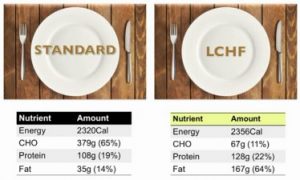
In contrast, the standard food choices provide 379 gm of carbs, 108 gm of protein, and only 35 gm of fat, for a similar number of calories. This person will never empty their glycogen store, will be in glucose-burning mode all the time, storing unused glucose as fat, and slowly gaining weight.
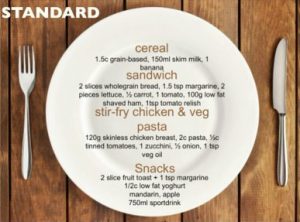
Conclusion
Dr Caryn Zinn’s LCHF meal suggestions will provide some weight loss, and many of the benefits of carbohydrate reduction for most people.
Athletes usually need special consideration, and will need to modify their carbohydrate, protein, and fat ratios to achieve their performance and recovery targets.
By the way, Dr Zinn gave an excellent talk on the subject of sport and LCHF at the Ancestral Health Symposium, which you may like to watch.
If you are very over-weight, or diabetic, or have other health issues associated with insulin resistance and metabolic syndrome, you’ll need to get your carbs much lower than the 67 gm a day in Dr Zinn’s LCHF example day of meals – more like 20-30 gm a day – to get the full benefit of the LCHF lifestyle.
Please remember, healthy fats replace starchy carbohydrates and sugars: you can’t eat lots of carbs and lots of fat.
Book
Dr Zinn, whose getting-started video I recommend watching, co-authored a book with Professor Grant Schofield and chef, Craig Rodger.
Here’s a description of the book:
‘This Kindle edition book is more than just a diet plan or a cookbook – written by the Fat Professor (Professor Grant Schofield), the Whole-food Dietitian (Dr Caryn Zinn) & the Michelin-trained Chef (Craig Rodger) – it’s a new way of eating that will change your life. For good.
Low carb healthy fat eating has never been so easy. Welcome to the ultimate practical “how to” and scientific guide.’
If you prefer a hard copy real book, you can order it from the publisher in New Zealand. Airmail for the 1.5kg book to Malaysia is a very reasonable 25 NZD (about RM80).
Check it out at WhatTheFatBook.com
Blog
Prof Schofield has written a very good explanation on his blog of how to start the LCHF lifestyle, which you may like to read, too. The more info you have, the better.
Questions?
Got any questions before starting to enjoy LCHF meals? Please jot them in the comment box below and I’ll get back to you asap.
Ducks in a row?
And before you go, it’s useful to double-check your ducks are in a row, so please have a look through this short list:
- Been to your doctor for blood tests if you haven’t got fairly recent results.
- If you’re taking medicines, have discussed LCHF with your doctor.
- Know your weight, height, and waist measurement for your online BMI assessment.
- Signed up for the online food tracker to help you with food quantities, at least until you get used to proportions. Tip: entering the foods and drinks you’re consuming now will help identify the areas where you need to take extra care in the coming weeks.
- Talked about your LCHF goals with your family, and got their support.
Great! See you at the next post 🙂
N.B.
Please read the Medical Cautions page if you’re expecting a baby, or are taking medicines prescribed by your doctor, before you make any changes to your diet.
